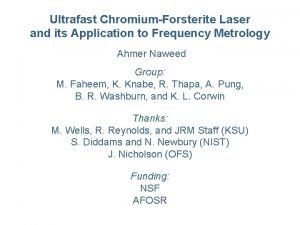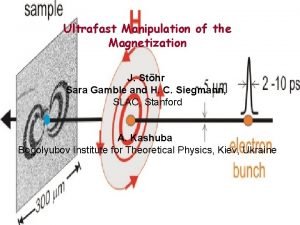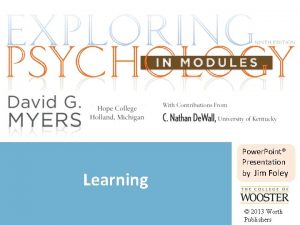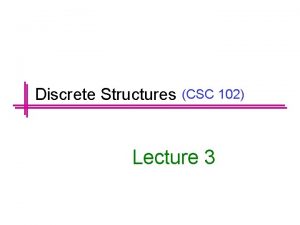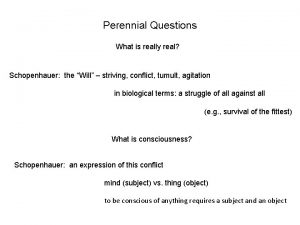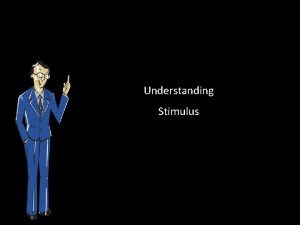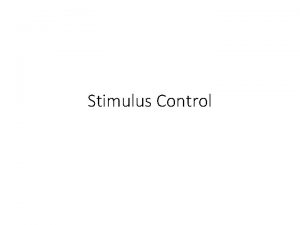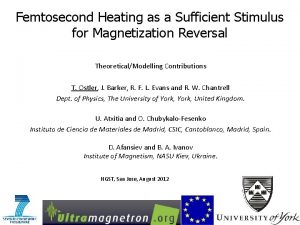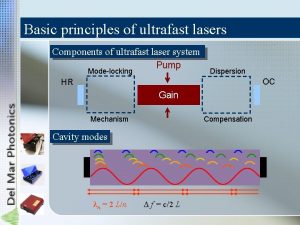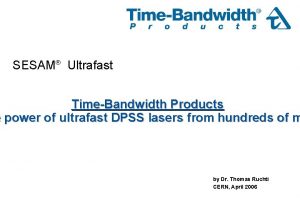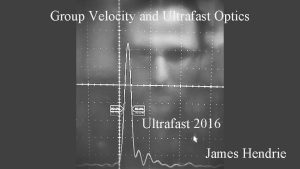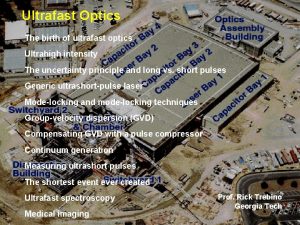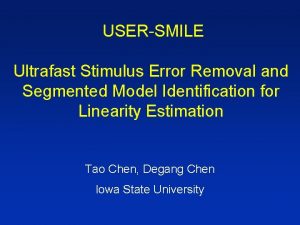Ultrafast Heating as a Sufficient Stimulus for Magnetisation














- Slides: 14

Ultrafast Heating as a Sufficient Stimulus for Magnetisation Reversal in a Ferrimagnet (reversal of a bistable magnetic system with heat alone!) T. Ostler, J. Barker, R. F. L. Evans and R. W. Chantrell Dept. of Physics, The University of York, United Kingdom. U. Atxitia and O. Chubykalo-Fesenko Instituto de Ciencia de Materiales de Madrid, CSIC, Cantoblanco, Madrid, Spain. S. El Moussaoui, L. Le Guyader, E. Mengotti, L. J. Heyderman and F. Nolting Paul Scherrer Institut, Villigen, Switzerland A. Tsukamoto and A. Itoh College of Science and Technology, Nihon University, Funabashi, Chiba, Japan. D. Afansiev and B. A. Ivanov Institute of Magnetism, NASU Kiev, Ukraine. A. M. Kalashnikova , K. Vahaplar, J. Mentink, A. Kirilyuk, Th. Rasing and A. V. Kimel Radboud University Nijmegen, Institute for Molecules and Materials, Nijmegen, The Netherlands. MMM, Scottsdale, AZ Oct/Nov 2011

Motivation • • • Recently we showed recently that using linearly polarised laser pulses, in the presence of a magnetic field, that we can induce switching in ferrimagnetic (Gd. Fe. Co). What is the role of the magnetic field? Showed that reversal occurs via a so-called transient ferromagnetic-like state. For more on this see (ED-07). anti-parallel ground state. align parallel application of laser pulse What is the role of the magnetic field? Can we see reversal without it? H Gd ? H Fe Initially sublattices align antiparallel. Fe demagnetis es very quickly and reverses to align with Gd. Gd then reverses. Back to ground state. Radu et al. Nature 472, 205 -208 (2011).

Overview • (Brief) details of numerical model. • Results of numerical model. • Experimental confirmation of switching in thin films of Gd. Fe. Co, independent on initial state. • Switching in microstructures using linearly polarised laser pulse. • Mechanism for switching?

Numerical Model • Gd. Fe. Co is amorphous. • In numerical model we allocate Gd and Fe spins randomly on closed packed lattice to required composition. • Exchange parameters paremeterised on experimental observations Fe JFe-Fe >0 (ferromagnetic) JFe-Gd<0 (antiferromagnetic) Gd JGd-Gd>0 (ferromagnetic) • Model features local moment variation m. Fe< m. Gd, important for reversal. • We can use the model to observe the dynamics of individual spins with time. Atomic Level Macrospin For more details on this model see Ostler et al. Phys. Rev. B. 84, 024407 (2011).

Numerical Results • Starting temperature is 300 K. Sequence of 50 fs (FWHM) gaussian heat pulses. • Increases electronic temperature (TTM[1]) to which the spin system in coupled. • Heat dissipates on 100 ps time-scale. • Reversal occurs each time a pulse is applied. • No applied field throughout simulation. [1] - Chen et al. International Journal of Heat and Mass Transfer, 49, 307 -316 (2006).

Switching in Gd. Fe. Co Thin Films • We have experimentally verified the switching mechanism by studying the response of ferrimagnetic Gd 24 Fe 66. 5 Co 9. 5 to the action of 100 fs (FWHM) right circularly polarised laser pulses. • After action of each pulse the magnetization switches, independently of initial state. Fe Initially film magnetised “up” Gd MOKE n n Similar results for film initially magnetised in “down” state. Beyond regime of all-optical reversal, i. e. cannot be controlled by laser polarisation. Therefore it must be a heat effect. Stanciu et al. Phys. Rev. Lett. 99, 047601 (2007). 20 mm

Reversal in Microstructures n Reversal seen in 2 mm microstructures of Gd 25 Fe 65. 6 Co 9. 4. n Large enough distance apart to eliminate dipolar coupling effect. n Magnetisation direction measured using a PEEM employing the XMCD effect (measuring Fe edge). n Switching occurs every time, even with just linearly polarised light. 2 mm XMCD

Mechanism of Reversal • What breaks the symmetry? • Numerical simulations suggest that the fact that the sublattices are non-equivalent in longitudinal relaxation time is key for reversal. time 0 ps anti-parallel ground state. ~1 ps Fe demagnetises faster than Gd. ~2 ps Fe spins reverse and begin to form “stable” sublattice. ~3 ps AFM exchange field drives Gd to opposite state.

Summary/Outlook • Demonstrated numerically switching can occur using only a heat pulse without the need for magnetic field. • Shown that reversal with polarised light on thin films can occur independently on polarisation and initial state. • Microstructures show switching under the action of linearly polarised laser. • Have shown that stray fields do not play an effect in the mechanism. • The importance of the non-equivalence in longitudinal relaxation times of the sublattices. • This switching mechanism is a feature of this type of ferrimagnetic material and only requires heat!

Acknowledgements n Experiments performed at the SIM beamline of the Swiss Light Source, PSI. Nederlandse Organisatie voor Wetenschappelijk Onderzoek (NWO), de Stichting voor Fundamenteel Onderzoek der Materie (FOM). n n The Russian Foundation for Basic Research (RFBR). European Community’s Seventh Framework Programme (FP 7/2007 -2013) Grants No. NMP 3 -SL-2008214469 (Ultra. Magnetron) and No. 214810 (FANTOMAS), n n Spanish MICINN project FIS 2010 -20979 -C 02 -02 European Research Council under the European Union’s Seventh Framework Programme (FP 7/20072013)/ ERC Grant agreement No 257280 (Femtomagnetism). n n NASU grant numbers 228 -11 and 227 -11. Thank you for listening.

Numerical Model • Energetics of system described by Hamiltonian: n Dynamics of each spin given by Landau-Lifshitz-Gilbert Langevin equation. n Effective field given by: n Moments defined through the fluctuation dissipation theorem as:

Helicity Independent Switching n Previously it was shown that all-optical reversal controllable using circular polarisation of light[1]. Beyond a certain pump fluence we have shown that this control is not possible and the system reverses independently on polarisation. n High Fluence n Below threshold fluence pump fluence see control of magnetisation. Low Fluence [1] - Stanciu et al. Phys. Rev. Lett. 99, 047601 (2011).

The Effect of Compensation Previous studies have tried to switch using the changing dynamics at the compensation point[ref]. n Simulations show starting temperature not important. n Supported by experiments on different compositions of Gd. Fe. Co support the numerical observation. n

Effect of Field • So far all results show reversal in no field, with numerical model showing the mechanism is mediated by the transient ferromagnetic-like state. • What happens now if we apply a field to oppose the formation of this state? • Numerical model shows that in certain conditions the field required to prevent the formation of this state can be 40 T! • Field required to prevent formation of this state depends on measurement time as system will begin to precess back.
 Magnetism and electricity
Magnetism and electricity Ultrafast
Ultrafast Ultrafast demagnetization
Ultrafast demagnetization Ultrafast magnetism
Ultrafast magnetism Difference between induction heating and dielectric heating
Difference between induction heating and dielectric heating Learning is any relatively permanent change
Learning is any relatively permanent change Conditioned stimulus psychology definition
Conditioned stimulus psychology definition Unit 6 ap psychology
Unit 6 ap psychology Sufficient statistics
Sufficient statistics A single countermeasure is sufficient for sqli attacks.
A single countermeasure is sufficient for sqli attacks. Necessary and sufficient conditions examples
Necessary and sufficient conditions examples Apollonian and dionysian
Apollonian and dionysian Vocabulary workshop level d unit 12 synonyms
Vocabulary workshop level d unit 12 synonyms P/q
P/q Patent impressions are
Patent impressions are

